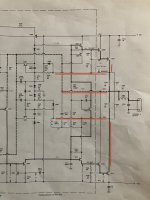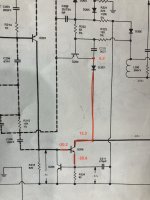Hi I just have some new guy questions as I troubleshoot a solid state amp I have. I have an amp that has a short I believe, it is pulling a high current shown on my Variac as I increase toward 120V. I have it set to where it only pulls about .1 amp and what I am doing from here is just probing around trying to learn and see what some voltages are in various places across capacitors, resistors, diodes and transistors.
My question is, as I probe around, are there any tell tale signs of any issues for example, would 0 voltage drop across a resistor possible mean a shorted resistor? Same for a capacitor? I know this is a vague question but looking for any advice and/or things I can look for in this scenario.
Thank you in advance!
My question is, as I probe around, are there any tell tale signs of any issues for example, would 0 voltage drop across a resistor possible mean a shorted resistor? Same for a capacitor? I know this is a vague question but looking for any advice and/or things I can look for in this scenario.
Thank you in advance!
Hard to say, the circuit won't work right at a low input voltage. Regulators may drop out.
Some amps could have an undervoltage lockout function. Or some could even fail from low input voltage.
You could disconnect power to one channel and see if the problem is still there. If not, it may be in the other channel only.
Then start checking all the parts unpowered in the bad channel.
Some amps could have an undervoltage lockout function. Or some could even fail from low input voltage.
You could disconnect power to one channel and see if the problem is still there. If not, it may be in the other channel only.
Then start checking all the parts unpowered in the bad channel.
I understand, okay the one thing I did that I do not think tells me much is when I disconnect the negative rail there is no issue. By the way this is a Crown D150a. I have just gotten to the point where I feel like I am running around the schematic in ciricles and blindly replacing parts. I did find a couple bad transistors that I replaced but now I am stuck on channel two, where I have a lower voltage as compared to the other channel.
Anyway, I just ran out of ideas and feel stuck so I am taking a break for a while but I just wanted to see if I was missing any basic troubleshooting steps. Oh, also, all drivers and outputs test fine, they are new though.
Anyway, I just ran out of ideas and feel stuck so I am taking a break for a while but I just wanted to see if I was missing any basic troubleshooting steps. Oh, also, all drivers and outputs test fine, they are new though.
So the collector of the Positive output is connected to the positive rail and then that emitter is connected to the collector of the negative output, then the negative output emitter is connected to the negative rail. The voltage on the emitter (positive output) collector (negative output) on one channel has lower voltage as compared to the other side. Here is a photo of channel two, I highlight in red two places where it goes by wire back to the driver board. Also, if you see D207, I have another photo where there is a higher drop there as compared to the other side. Both photos attached. So I am kind of assuming the channel that has the lower voltage, has the short? maybe?
Attachments
This is an ancient amp with a screwy circuit. Odds are it's not gonna be easy to fix.
And some critical parts may be unavailable.
And some critical parts may be unavailable.
I am a novice, total greenhorn, I have been messing with this thing for a few months now like I said just running in circles, it would take me a week to tell you what I have already tried lol but yea I am starting to see it is screwy! So, one thing, many people point to the zeners normally failing (replaced them) and also the IC. I have pulled the IC and powered up and the short seems to still be there, not sure if that was a good idea or proves it to be good necessarlily but that just tells me the short is somewhere else. I have tested and replaced dang near all the transistors and many resistors and diodes. Not much left but at some point I am going to say screw it and just start replacing all the parts, I have just about lost my mind on this thing! 

This is not the way . You need someone who knows how to fix these obsolete old amps.
There won't be many left at this point, though. Personally, I wouldn't waste my time.
Sell it on ebay for parts, or use the chassis to build a different amp.
There won't be many left at this point, though. Personally, I wouldn't waste my time.
Sell it on ebay for parts, or use the chassis to build a different amp.
On one had I agree but on the other hand, this is the only way to learn so I will trudge on. I know it is stupid to just throw parts at it but I have too much invested to just sell it for nothing which is most likely what I will get on eBay. I will just carry on and hopefully learn something.
Maybe, but this is not a thing on which you will learn much that is otherwise useful.
The phrase "throwing good money after bad" comes to mind here.
Hacking around is like the Socratic method of inquiry, unfocused and running around in circles.
Look into some tutorials that are intended to be educational.
Get a used second edition of "The Art of Electronics" by Horowitz and Hill.
The phrase "throwing good money after bad" comes to mind here.
Hacking around is like the Socratic method of inquiry, unfocused and running around in circles.
Look into some tutorials that are intended to be educational.
Get a used second edition of "The Art of Electronics" by Horowitz and Hill.
Last edited:
Thank you will do! I will focus on other things but keep this as a side project. There is plenty more to learn and grow but I am a stubborn man and will keep wokring on this. Maybe go a little slower though and try and take a more methodical scientific approach as opposed to working fast and throwing parts at it. Plus, I still have that Eico ST70 that needs work 🙂
The older you get, the less stubborn you will be, because of the lesser amount of time you will have left.
There's a limited amount you can do without a good foundation.
There's a limited amount you can do without a good foundation.
Never thought of it that way but so true! I am 43 years old, I have an engineering degree just not electrical, trying to learn but you are right, time is ticking so I guess you have to pick your battles!
Exactly.
And the result has to be worthy of your investment of time, effort, and money.
And the result has to be worthy of your investment of time, effort, and money.
My goal is just to be able to learn enough to make it to retirement with enough knowledge that would allow me to work on these part time, not to make too much money but just have some fun and help some people out, and make a few bucks, why not. But yea, I am very curious what this hobby will look like in 20 or so years!
Not sure this sort of knowledge will be useful in 20 years.
We'll see, at least some of us.
We'll see, at least some of us.
That's already the issue, even for recent designs.
Pass Labs and First Watt bought many pallets full of no-longer-made semiconductors.
And they're not the only ones.
Pass Labs and First Watt bought many pallets full of no-longer-made semiconductors.
And they're not the only ones.
Maybe the need will drive someone or some companies to start manufacturing these things again maybe not sure what that entails but I know they’re doing that with some old automotive parts for classic cars
Anyone know the cost for a single production run in a modern fab? I suspect its prohibitive for runs less than a few dozen wafers, and wafers are a lot bigger than they used to be too...
- Home
- Amplifiers
- Solid State
- In-circuit testing questions

